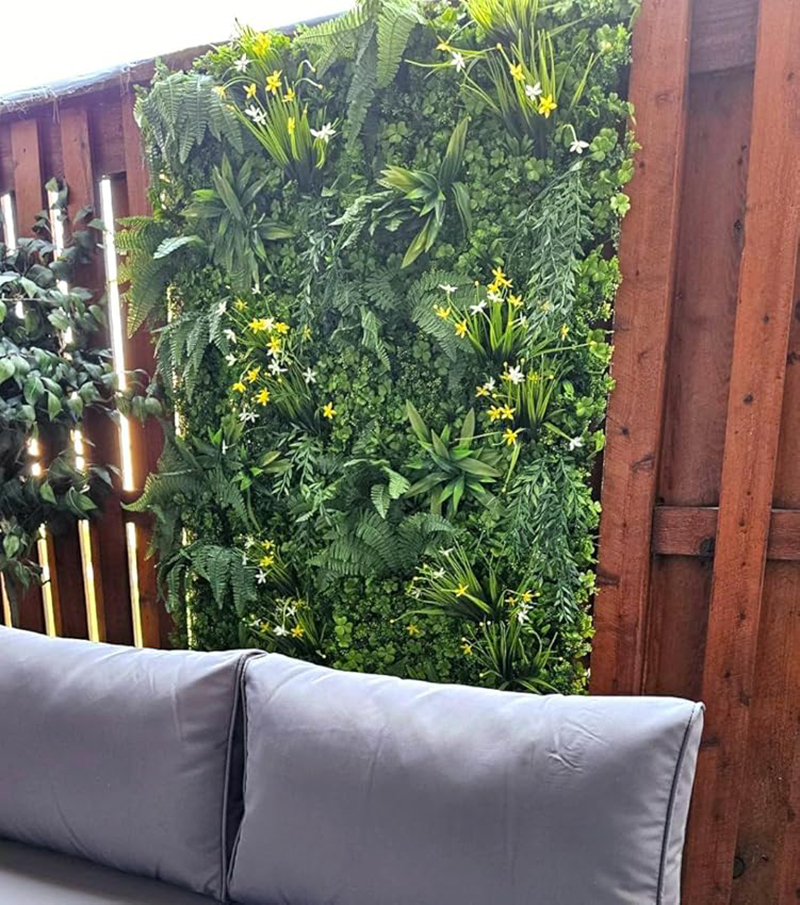Indoor vertical gardens break through spatial limitations through three-dimensional planting, but they need to address environmental challenges such as light, humidity and ventilation. The following analysis is conducted from four dimensions: design goals, technical adaptation, plant selection, and maintenance management, with a focus on addressing the compatibility issue between the indoor environment and vertical gardens.
Improve the utilization rate of space
Increasing the green coverage rate within a limited area, for instance, by converting walls into plant carriers, can enhance the spatial greening efficiency by 3 to 5 times (compared with flat planting).
Improve the indoor microclimate
Regulate humidity through plant transpiration to reduce air conditioning energy consumption; Dust is adsorbed on the surface of the leaves, reducing the concentration of PM2.5.
Psychological healing and aesthetic value
Green plants can reduce visual fatigue and enhance the comfort of the space. The combination of color and form can create immersive scenes with natural themes.
Illumination compensation scheme
Natural light utilization: Prioritize south-facing or east-facing walls to ensure at least 4 hours of diffused light per day.
Artificial supplementary lighting
Use LED plant lights (with a red and blue light ratio of 6:1), and hang them at a height of 30 to 50 centimeters from the plant canopy.
The light cycle is set at 14 hours of light and 10 hours of darkness to simulate the natural circadian rhythm.
Ventilation and humidity control
Passive ventilation: Reserve a gap of no less than 30 centimeters on both sides of the vertical garden to form air convection channels.
Active ventilation: Install small exhaust fans (with an air volume of ≥50m³/h), and change the air 1-2 times per hour to reduce local humidity.
Humidity regulation: The moisture content of the substrate is controlled through the drip irrigation system (maintained at 40%-60%) to prevent condensation on the leaf surface.
Irrigation system Optimization
Capillary irrigation or drip arrow technology is adopted to achieve precise water supply and reduce the risk of substrate caking.
Install the humidity sensor to be linked with the solenoid valve. When the moisture content of the substrate is lower than the threshold, it will automatically replenish water.
Environmental tolerance
Shade-tolerant plants: Give priority to varieties with lower light requirements such as Pothos, turtle-back bamboo, and Boston fern.
Low-transpiration plants: such as Sansevieria trifasciata and aloe vera, reduce the frequency of artificial humidification.
Growth rate matching
Avoid choosing plants that grow too fast (such as ivy) to prevent covering the maintenance passage within 3 to 6 months.
Adopt a combination of "fast growth + slow growth", for instance, fill the bottom layer with vitriol (slow growth) and decorate the upper layer with coleus (fast growth).
Safety considerations
Do not use toxic plants (such as water lily and croton), and keep children or pets away from accidental contact.
Reduce the use of thorny plants (such as cacti) to prevent the risk of scratches.
Pest and disease control
Preventive measures:
High-temperature sterilization of the substrate (steam treatment at 120℃ for 30 minutes) to kill eggs and pathogenic bacteria;
Hang yellow sticky boards to trap small pests such as aphids and whiteflies.
Governance strategy:
When red spiders are found, rinse the back of the leaves with high-pressure spray.
For powdery mildew, spray a 0.5% baking soda solution (with a pH value of 8.3, which can inhibit the pathogenic bacteria).
Substrate and fertilizer management
Substrate selection:
Mix peat soil (water-retaining), perlite (breathable), and coconut coir (lightweight) in a ratio of 4:3:3 by volume.
Add slow-release fertilizer granules (1-1.5 kilograms per cubic meter of substrate), and the fertilizer effect will last for 6-8 months.
Fertilization strategy:
During the growth period, apply foliar fertilizer once a month (with a nitrogen, phosphorus and potassium ratio of 20-10-20) at a concentration of 0.1%-0.2%.
Stop fertilizing during the winter dormancy period to avoid salt accumulation.
Structural safety inspection
Check the load-bearing capacity of the planting module fasteners (such as expansion bolts and hooks) every quarter to ensure there is no loosening.
Monitor the total weight of the plants (including substrate and water). The load of a single module should be ≤50kg/m² to prevent the wall from falling off.
Commercial space
Case: The vertical garden wall in the atrium of the shopping center, combined with the fog forest system, creates a "rainforest" themed landscape.
Technical key points:
Use a combination of shade-tolerant foliage plants (such as Calathea and silver queen) to reduce maintenance costs;
Install a background music system to simulate natural soundscapes and increase the time customers stay.
Office space
Case: A vertical garden with partitions in an open-plan office, which serves both sound insulation and beautification functions.
Technical key points:
Choose plants with low volatile organic compounds (VOCs), such as spider plants and white palms, to improve air quality;
The modular design is convenient for quick disassembly and can adapt to the adjustment of spatial layout.
Residential space
Case: A vertical garden at the corner of the living room in a small-sized apartment serves as a visual focal point to separate the space.
Technical key points:
The automatic irrigation system is adopted and remotely controlled through a mobile phone APP to reduce manual intervention.
Pair it with drought-resistant succulents (such as lithops and aloe vera) and reduce the frequency of watering.
Conclusion
The application of 3D artificial vertical gardens indoors needs to achieve sustainability through technical adaptation (lighting, ventilation, irrigation), plant selection (shade tolerance, low maintenance), and dynamic management (monitoring, adjustment). Its core value lies in integrating natural elements into enclosed Spaces, while maintaining a balance between aesthetics and functionality to avoid ecological imbalance or safety hazards caused by improper maintenance.

Contact: Amy
Phone: 86-15311787313
E-mail: info@foszmac.com
Whatsapp:86-15311787313
Add: Fengtai District, Dacheng Road, No.24 Building, Room 203, Beijing, China